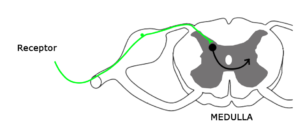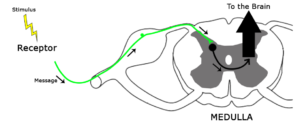I have been asked by a few patients about referral pain lately and I thought that it might interest you as well as…it’s truly quite intriguing. How can an organ be responsible for feeling pain somewhere else in the body, in a body part with no issues and at a distance of this organ? Quite strange isn’t it? Let’s see how this works.
How the nervous system is organized
To understand how things work, some basic anatomy explained would be of great help. Don’t worry, we’ll stay very superficial and simple here…the point of this article is not to make you top anatomists so I won’t be drowning you in deep details, just keep in mind that things are a little more complicated than what you will see here 🙂
So, in our case, we’re interested in the system that detects stimulus (i.e pressure, stretching, pain…) and conduct this information to the brain which will process it to coordinate a proper and adapted reaction (we won’t get into the reaction part as it’s not useful for our topic).
First we need something to react to a stimulus, that’s what we call a Receptor. There are various types receptors in the body reacting to specific stimuli. Some will be specialized in detecting changes of pressure, while others are focused on detecting stretching (like in the tendons for example), others can detect changes of temperatures, pain, etc. These receptors are located in the tissues of the body, for instance in your skin, your muscles, your organs, even in your arteries to control the concentration of Oxygen and Carbon Dioxide in your blood…
Then we’ll need a way for these receptors to send a message with this information to the brain: the Neurons, nervous fibres. One receptor will be connected to one neuron which will make its way through the body along other nervous fibres composing larger structures, the nerves. One nerve is constituted by a lot of different neurons from different parts and tissues of the body, conducting different information. These nerves will lead the neurons to the spine and the Medulla, where they will connect with other neurons to conduct the message inside the medulla.
From here there are different possibilities:
1 – An action will be decided right there in the medulla without going through the brain and a message will be sent via other nervous fibres to create a reaction of the body. That’s how reflexes work…for instance when there is an abrupt stretch on a tendon then your muscle will contract to prevent that stretching from going too far and protect your body (this one doesn’t concern our case).
2 – One neuron in the medulla will be specific to a neuron from a receptor and communicate only with it, and send the message to the brain. That’s the case for instance for the receptors temperature-sensitive in your skin. If you accidently put your hand on a plate that is just coming out of the oven, the brain has to know specifically where it burns so it can order the muscles of your arm to contract and remove the hand as fast as you can.
3 – One neuron in the medulla will connect to different neurons from different receptors located in different places in the body, and send the message to the brain (that’s the one involved in our topic).

The pain signal
Now that you know a little bit more about the structure, let’s see how it’s being used by the body.
So, back to our receptor…a stimulus is happening and activates it. For a better understanding let’s use an example here…Let’s say a receptor, one that is stretch-sensitive, located in the membrane of your intestine is detecting too much expansion, too much stretching, like if it was very bloated. The receptor will need to inform the brain there is something wrong here, so it creates a pain signal. To do so, the receptor will convert this stretching stimulus into an electric influx, an electric message which will propagate along the neuron it is connected with.
This neuron, or nervous fibre, will bring this pain signal via the nerve it is going through (remember, along other neurons from other receptors located elsewhere in the body, this will be important later) to the medulla where it will connect to an other neuron which will be in charge of sending the message through the medulla and deliver it to the brain.
The brain will now know that something is wrong with the intestine. It will recognize a pain signal and will determine where it’s coming from by the neuron bringing the information to the brain (well, it’s a little more complicated than that but it’s better to keep it simple).

Referred pain
This phenomenon occurs because of what we’ve seen earlier – some neurons in the medulla can be connected to different neurons from the nerve.
When in the medulla the neuron which sends the message to the brain is specific to the nervous fibre from the nerve, there is no problem – One neuron in the medulla for one neuron from one receptor in one location…. piece of cake for the brain!
Things get complicated in the case where one neuron in the medulla connects with several neurons from the nerve bringing messages from different receptors in different locations. One neuron for different receptors, from different parts of the body… hence why the brain can get confused and misinterpret the message. The brain will recognize that it’s a pain signal, but it may not necessarily understand where the signal is coming from.
Let’s say something is happening with your Liver, could be anything but for instance it’s full of toxins and the pressure is increasing. Then, a receptor in your Liver will be activated and create a pain signal, an electric message which will be conducted by a neuron specific to this receptor and going through the body in the Phrenic nerve.
This Phrenic nerve will send this neuron to the medulla along with other nervous fibres like the ones coming from receptors located in the right shoulder. In this case, both these nervous fibres from the Liver and the right shoulder connect to the same neuron in the medulla which will deliver the message to the brain.
The brain will recognize a pain signal, but sometimes it can interpret the message as if it was coming from the right shoulder instead of the liver, or coming from both these areas instead of just one, the liver. And that’s how a perfectly healthy right shoulder can be painful for no reason! That’s how the referred pain phenomenon works!
Another well-known example of this phenomenon is the pain in the left arm and jaw described by people when having a Heart attack, it’s the same process.

Here are other examples of areas where you can feel referred pain from organs:

Radiating pain
This is not the subject of this article, but just to avoid any confusion as it’s also a pain you can feel at distance from where the actually problem exists, we’ll say a few words about it. This is a different type of pain and a different process.
Radicular pain is a pain you can feel along a nerve and/or in the nerve territory; most of the time (but not always) due to a compression of this nerve somewhere in the body. For instance, the well-known pain of the “sciatica” you might feel in your butt, at the back of your thigh, leg, and/or in your foot. This radicular pain may be the result of a compression of the Sciatic nerve in the spine by a herniated disc, or by the spasm of the Piriformis muscle that accompanies a twisted and misaligned pelvis.
Another example of radicular pain is seen in Carpal Tunnel Syndrome with symptoms in the hand and fingers due to a compression of the Median nerve in the forearm or the wrist.
So as you can see…even though you feel pain in one area, the very cause of that pain may be located at a distance from where you interpret the issue being. This process is very different from the referred pain, and it could be by itself a subject for an other article.
What about Osteopathy
In osteopathy, we always think of the whole body and how its different parts are connected and can affect each other. Osteopathic practitioners appreciate this phenomenon and keep it in mind as we are assessing and treating your body – it can sometimes explain the root cause of a pain and lead us to treat a specific organ. If we stay with our example of the liver and the right shoulder, we will assess your body and address the issues we can find which could be responsible for your shoulder pain like misalignment, muscles, ligaments etc. We will also investigate your liver to make sure it’s not also involved and a cause of that pain you’re feeling. We will assess and treat what presents – which may involve helping it to get rid of toxins, stimulate it if need be, check its whole ligament system to make sure it’s not creating other adaptations, feel if its mobility is good, and we’ll look for the root cause – if we don’t address that then it will just come back again and again.
So don’t be surprised if you come in for a shoulder pain and we spend time on your abdomen!
Of course an organ can impact another area in the body by various ways like: adaptations, by pulling through its ligaments on the structures and tissues surrounding him, affecting in their turn further tissues etc.
But in this specific case, an organ would be responsible for a pain somewhere else just at a distance and without all this chain of adaptations leading to this other area.
I tried to keep it simple and not to lose you in a lot of details (useless in our case) about anatomy and physiology, but feel free to ask in your comments should you have any questions or need further information.

